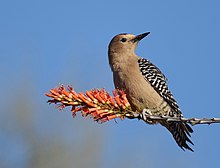User talk:Oyg20
|
Our first steps tour and our frequently asked questions will help you a lot after registration. They explain how to customize the interface (for example the language), how to upload files and our basic licensing policy (Wikimedia Commons only accepts free content). You don't need technical skills in order to contribute here. Be bold when contributing and assume good faith when interacting with others. This is a wiki. More information is available at the community portal. You may ask questions at the help desk, village pump or on IRC channel #wikimedia-commons (webchat). You can also contact an administrator on their talk page. If you have a specific copyright question, ask at the copyright village pump. |
|
-- Wikimedia Commons Welcome (talk) 06:01, 10 March 2020 (UTC)
Lower Region of the Colorado River: Plant and Animal[edit]
Animal in the Lower Region of the Colorado River[edit]
The animal I picked for the Lower Region of the Colorado River is the Gila Woodpecker. The kingdom is Animalia, phylum is Chordata, the family is Picidae and the species is M. Uropygialis. The wings of the bird are spotted and have a zebra-like pattern, they also have a grey and tan color neck, throat and belly. The difference between male and female Gila Woodpeckers is that males have a red cap on their head and females and the younger birds do not have the red cap. Many of these birds can be found in the low desert scrubs in the Sonoran Desert. Many of these birds male their homes in Saguaros or in the Honey Mesquite Tree. Breeding for these animals occurs in a hole in the Saguaro cactus. Typically they lay about three to four eggs and this usually occurs two or three times a year. Interestingly both males and females feed and incubate their eggs. The Gila Woodpecker usually feeds on insects but it will also feed on fruits, nectar, seeds, lizards, worms, and sometimes they will even eat young chicks. In California the number of Gila Woodpeckers has dropped drastically but in Arizona the number is remaining steady. It is believed that the drastic drop in number of Gila Woodpeckers in California is due to climate change. The Saguaro has been drastically effected by climate change and losing this habitat has had a negative impact on the Gila Woodpecker.

Plant in the Lower Region of the Colorado River[edit]
The plant I picked for the Lower Region of the Colorado River is the Honey Mesquite. The kingdom is Plantae, the family is Fabaceae, and the species is Prosopis Grandulosa. This tree can be found in Southwestern part of the United States, in California and Arizona, as well as the Northern part of Mexico. A unique feature on the branches is that it has long pea in a pod like branches. The tree can usually range from twenty to thirty feet tall but the tallest tree that was reported was about fifty feet tall. On this tree it can grow flowers and it usually has spikes that are pale and yellow. The seedpods that grow on the tree are a yellowish green color. These seedpods can be eaten by a variety of animals such as scaled quails, deer, collared peccaries, coyotes, and jackrabbits. It is very hard to get rid of this tree. Many of the buds underground are difficult to take out so if a tree were to get cut down it will be replaced by different trunks. This tree comes in handy for many different animals and not just for its source of food but it is also a great place for animals to live. A fun fact is that the seedpods on the tree can be used to make a different variety of sweet drinks and this is where the name Honey Mesquite came from, it sweetness. — Preceding unsigned comment added by Oyg20 (talk • contribs) 07:10, 10 March 2020 (UTC)

— Preceding unsigned comment added by Oyg20 (talk • contribs) 07:16, 10 March 2020 (UTC)

— Preceding unsigned comment added by Oyg20 (talk • contribs) 07:16, 10 March 2020 (UTC)